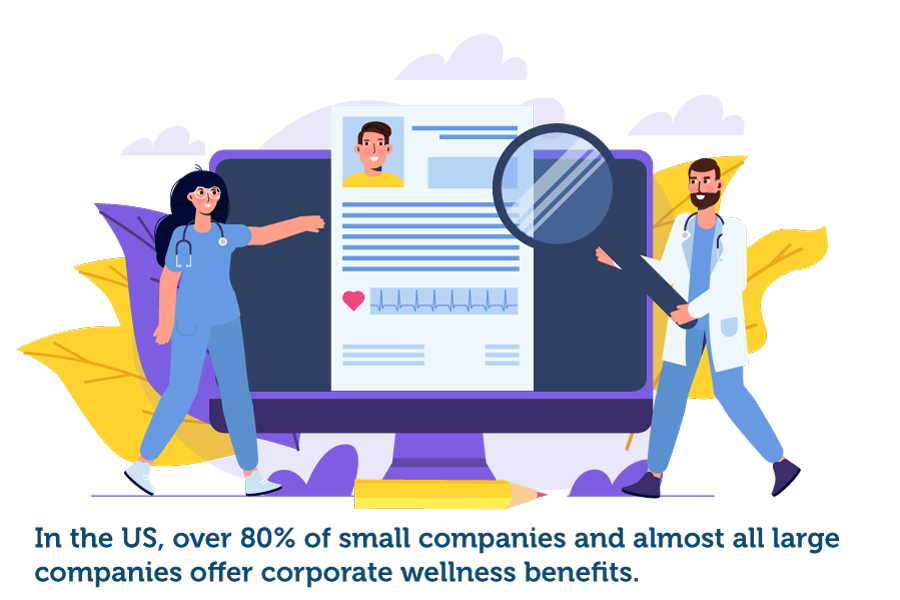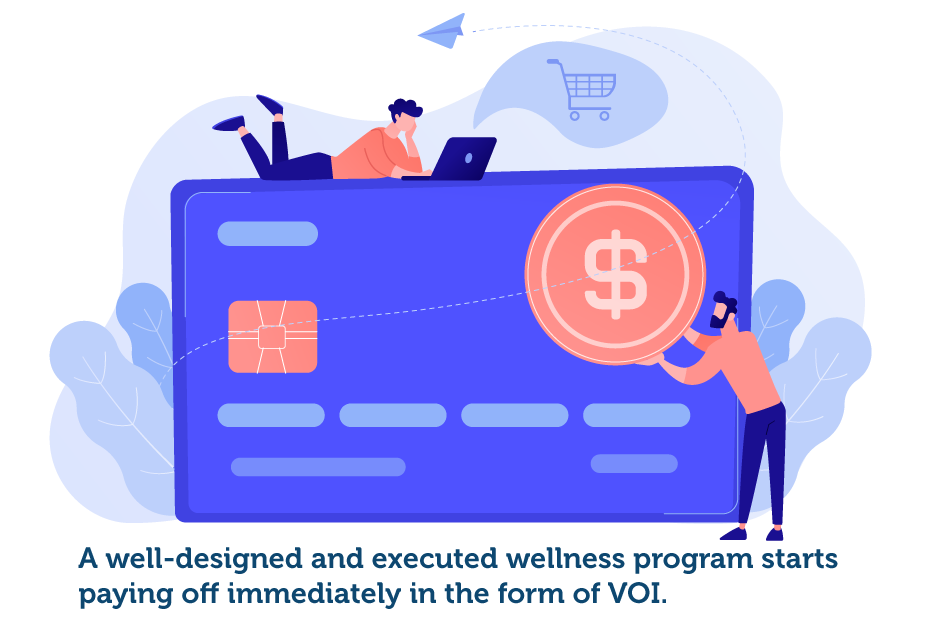
Why Does Your Company Need an Employee Benefits Platform?
From HR efficiency to employee retention, here’s why companies need to modernize their benefits administration with employee benefits platforms.


CEO & Founder of Breadnbeyond

Co-Founder of Milkwhale

Digital Marketing Manager of Explainerd
Amid soaring health care expenses, there is a growing interest in wellness companies and workplace disease prevention to improve employee health and lower costs.
Corporate wellness programs have become the norm for many US companies, with over 80% of small companies and almost all large companies offering some sort of corporate wellness benefit.
To continuously improve the effectiveness of wellness programs, employers need to measure their performance.
Despite the significance measurement and evaluation have for positive outcomes, this work is still challenging for employers. As a result, many companies seek clarity regarding the impact of wellness programs and ask, “how do you measure wellness.”
While it’s not easy to measure the outcome of wellness programs, tracking your program’s success is necessary to save money in the long run and improve the health of your employees.

“Wellness programs are essential in every company as they promote employee productivity and retention.
A recent study found that for each dollar spent on wellness programs, companies save an average of $3.27 in healthcare costs and $2.73 in absenteeism costs,” says Natasha Rei, Digital Marketing Manager of Explainerd.
A wealth of research shows that when incorporated correctly, the benefits of corporate wellness programs are plentiful. Lower insurance costs, happier and more motivated employees, and improved absenteeism rates all sound amazing. But despite all the wellness statistics, how do you know if your wellness plan is cost-effective and working out for you? How to measure employee well-being?
First, we must define benchmarks and measure outcomes to understand how to measure wellness. Employers can then use this data to evaluate the effectiveness and identify gaps in their own employee health offerings.
Ebnu Sudarso, Co-Founder of Milkwhale, shared which core indicators to consider tracking when measuring wellness. Sudarso comments, “So, how do you measure wellness in a corporate setting? There are several metrics.
The ones we find effective are:
A good way to measure these is by regularly checking in with your employees by holding routine meetings, surveys, or questionnaires. The key is to keep in touch with your employees and get to know how they are.”
Some core metrics to serve as benchmarks for a wellness survey include:
|
Process Measurement |
Impact Measurement |
Outcome Measurement |
|
Short-term oriented result |
Medium-term oriented result |
Long-term oriented result |
|
Participation rate |
Decreased Employee Health Risk (Measured by conducting health-risk assessments) |
Financial measurements – ROI calculations and cost-benefit analysis |
|
Employee satisfaction with program |
Improved Health Attitudes and Perceived Status (Measured through health surveys) |
Cost savings in health benefits and insurance claims – Worker’s compensation, long-term disability, short-term disability |
|
Perceived value |
Improved Employee Satisfaction (Measured by a questionnaire) |
Reduction in length of a disability associated with stress, or musculoskeletal and cardiovascular disorders |
|
Organizational support and management commitment |
Readiness for change (Measured through health surveys) |
Reduced incidence of illness associated with cardiovascular cases and musculoskeletal injuries
|
|
|
Reduced incidence of new cardiovascular cases and musculoskeletal injuries |
|
|
|
Employee empowerment (Measured by specific stress indicators) |
|
The success of the wellness programs depends on the specific purpose and goals each company wants to achieve. To measure their impact, objectives and base measurements must be set before the program starts. The program itself must also be reevaluated after it has been running for over a year.
Natasha Rei explains this further by commenting, “How do you measure wellness? Here are the simple steps.
If you see an improvement in these indicators after implementing a wellness program, then it is safe to say that your wellness program is effective and benefits your company.”
Despite the common belief that wellness programs should produce an ROI of at least one dollar per dollar invested in its first year, research demonstrates that savings can only be expected after the program’s second year. Follow-up evaluations should be done at the 5-year and 10-year mark.
Andre Oentoro, CEO & Founder of Breadnbeyond, shared that health insurance claims data, surveys, and participation in wellness activities are all significant indicators of a successful wellness program.


The simple way to calculate the Return on Investment (ROI) of wellness programs is to answer: How much money is saved for every dollar spent on employee wellness?
Calculating the ROI is a traditional evaluation approach where we measure the cost-effectiveness of wellness programs through direct financial indicators, such as a reduction in healthcare claims. While it may sound straightforward, not all wellness outcomes are measurable or quantifiable.
To further understand this, we must know the main goals of wellness programs which are:
Considering the main goals of wellness programs are to save money through preventive interventions rather than generating revenue, a straight ROI analysis isn’t always relevant.
When measuring wellness, you must consider that you are investing in lowering longer-term costs, and the real benefits may take a while to emerge. Creating healthy habits takes time, so it could be years before an organization can calculate an accurate ROI on a wellness program.
Improving employees’ health comes with many intangible “softer” benefits like increased productivity, morale, and engagement that positively affect the bottom line.
“When employees are happy, they’re productive and keep the company running smoothly. When a company lacks wellness, you can expect productivity to decrease and retention rates to lower,” explains Ebnu Sudarso.
However, these non-traditional leading metrics of employee well-being may not produce a specific dollar value outcome like ROI analysis.
Hence, the wellness trends appear to be shifting away from calculating ROI and instead focusing on evaluating the success of wellness programs based on their Value on Investment (VOI). In fact, most employers no longer use cost-effectiveness as the primary measure to assess their wellness programs.
Value on investment is a financial analysis that reflects the broader economic impact wellness programs have on organizations. Today, employers realize that even a slight rise in productivity or a decline in turnover rates can drive business returns far more remarkable than savings from a traditional cost shift in a medical plan design.
While it may take a few years to see a positive ROI from wellness programs, a well-designed and executed program starts paying off immediately in the form of VOI. The scales to measure employee well-being and its benefits for the organizations are a balanced combination of ROI and VOI.

Constructing a framework that accurately answers “how do you measure wellness” is not a simple task. Measuring success in corporate wellness programs is done not only by lowering medical spending but through many tangible and intangible health improvements that ultimately lead to long-term positive business outcomes.
Browse our curated list of vendors to find the best solution for your needs.
Subscribe to our newsletter for the latest trends, expert tips, and workplace insights!

From HR efficiency to employee retention, here’s why companies need to modernize their benefits administration with employee benefits platforms.

Discover flexible benefits plan’s role in improving recruitment and retention levels and satisfying employees’ needs.

In this era of digital transformation, technology has emerged as a powerful catalyst, amplifying the reach and impact of employee wellness programs in the workplace.

Unlock the secret to a longer, healthier, and happier life: It’s not just about steps and veggies, it’s about the power of meaningful social connections.
Used by most of the top employee benefits consultants in the US, Shortlister is where you can find, research and select HR and benefits vendors for your clients.
Shortlister helps you reach your ideal prospects. Claim your free account to control your message and receive employer, consultant and health plan leads.